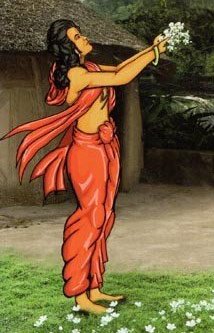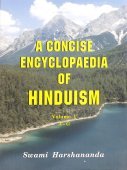Kanakhala, Kanakhāla, Kanakhalā: 13 definitions
Introduction:
Kanakhala means something in Buddhism, Pali, Hinduism, Sanskrit. If you want to know the exact meaning, history, etymology or English translation of this term then check out the descriptions on this page. Add your comment or reference to a book if you want to contribute to this summary article.
In Hinduism
Purana and Itihasa (epic history)
Source: archive.org: Puranic Encyclopedia1) Kanakhala (कनखल).—The place where the Dakṣayāga was conducted. (Chapter 4, Vāmana Purāṇa).
2) Kanakhala (कनखल).—A holy place on the shores of the river Gaṅgā. If one bathes in this river one gets the benefit of performing an Aśvamedha sacrifice. (Śloka 30, Chapter 84, Vana Parva). Kālidāsa speaks about this place in his famous work 'Meghadūta'. At the behest of Vasiṣṭha, Takṣaka, son of Lakṣmana, conquered the foresters of Kanakhala and then established a city there called Agatī. (Uttara Rāmāyaṇa).
Source: archive.org: Shiva Purana - English TranslationKanakhala (कनखल) is the name of an ancient locality where once took place the sacrifice of Dakṣa, as mentioned in the Śivapurāṇa 2.2.27. Accordingly as Brahmā narrated to Nārada:—“[...] once a great sacrifice was started by Dakṣa, [...] In that sacrifice that was being performed in that holy place of Kanakhala, Bhṛgu and other sages were made Ṛtviks by him (Dakṣa). Viṣṇu himself was the presiding officer along with the Maruts. I was the Brahmā (a special officiating deity) the director and guide for Vedic rituals”.
Note: Kanakhala is a sacred town, near Haradvāra, on the Ganges where Dakṣa performed the great sacrifice in which Satī burnt herself. The river Gaṅgā is held very sacred at Kanakhala.
Source: Cologne Digital Sanskrit Dictionaries: The Purana Index1a) Kanakhala (कनखल).—A sacred place on the Ganges, where Garuḍa performed tapas. Here Śiva danced with a yoginī. Bath here leads to Rudralokam.*
- * Matsya-purāṇa 186. 10; 192. 11; 193. 69-71; Vāyu-purāṇa 83. 21.
1b) A tīrtha in Gaya; on its right side is Dakṣiṇamānasa.*
- * Vāyu-purāṇa 111. 7.
Kanakhala (कनखल) refers to the name of a Tīrtha (pilgrim’s destination) mentioned in the Mahābhārata (cf. III.82.26, III.88.19). Note: The Mahābhārata (mentioning Kanakhala) is a Sanskrit epic poem consisting of 100,000 ślokas (metrical verses) and is over 2000 years old.

The Purana (पुराण, purāṇas) refers to Sanskrit literature preserving ancient India’s vast cultural history, including historical legends, religious ceremonies, various arts and sciences. The eighteen mahapuranas total over 400,000 shlokas (metrical couplets) and date to at least several centuries BCE.
Shaivism (Shaiva philosophy)
Source: Wisdom Library: ŚaivismKanakhāla (कनखाल) is a Sanskrit word referring to one of the sixty-eight places hosting a svāyambhuvaliṅga, one of the most sacred of liṅgas according to the Śaivāgamas. The presiding deity residing over the liṅga in this place (Kanakhāla) is named Rudra. The list of sixty-eight svāyambhuvaliṅgas is found in the commentary of the Jirṇoddhāra-daśaka by Nigamajñānadeva. The word liṅga refers to a symbol used in the worship of Śiva and is used thoughout Śaiva literature, such as the sacred Āgamas.

Shaiva (शैव, śaiva) or Shaivism (śaivism) represents a tradition of Hinduism worshiping Shiva as the supreme being. Closely related to Shaktism, Shaiva literature includes a range of scriptures, including Tantras, while the root of this tradition may be traced back to the ancient Vedas.
Kavya (poetry)
Source: Wisdom Library: KathāsaritsāgaraKanakhala (कनखल) is the name of a place of pilgrimage, according to the Kathāsaritsāgara chapter III. Accordingly, “There is a sanctifying place of pilgrimage, named Kanakhala, at the point where the Ganges issues from the hills, where the sacred stream was brought down from the tableland of Mount Uśīnara by Kāñcanapāta, the elephant of the gods, having cleft it asunder.”.
The Kathāsaritsāgara (‘ocean of streams of story’), mentioning Kanakhala, is a famous Sanskrit epic story revolving around prince Naravāhanadatta and his quest to become the emperor of the vidyādharas (celestial beings). The work is said to have been an adaptation of Guṇāḍhya’s Bṛhatkathā consisting of 100,000 verses, which in turn is part of a larger work containing 700,000 verses.

Kavya (काव्य, kavya) refers to Sanskrit poetry, a popular ancient Indian tradition of literature. There have been many Sanskrit poets over the ages, hailing from ancient India and beyond. This topic includes mahakavya, or ‘epic poetry’ and natya, or ‘dramatic poetry’.
General definition (in Hinduism)
Source: Wisdom Library: HinduismKanakhala (कनखल)—One of the several gaṭhas (bathing places) in the twelve forests on the banks of the Yamunā.
In Buddhism
Tibetan Buddhism (Vajrayana or tantric Buddhism)
Source: Wisdomlib Libary: VajrayanaKanakhalā is the name of a mahāsiddha, of which eighty-four in total are recognized in Vajrayāna (tantric buddhism). His title is “the younger severed-headed sister”. He lived somewhere between the 8th and the 12th century AD.
These mahāsiddhas (e.g., Kanakhalā) are defined according to the Abhayadatta Sri (possibly Abhayākaragupta) tradition. Its textual origin traces to the 11th century caturāsiti-siddha-pravṛtti, or “the lives of the eighty-four siddhas”, of which only Tibetan translations remains. Kanakhalā (and other Mahāsiddhas) are the ancient propounders of the textual tradition of tantric or Vajrayana Buddhism.

Tibetan Buddhism includes schools such as Nyingma, Kadampa, Kagyu and Gelug. Their primary canon of literature is divided in two broad categories: The Kangyur, which consists of Buddha’s words, and the Tengyur, which includes commentaries from various sources. Esotericism and tantra techniques (vajrayāna) are collected indepently.
Languages of India and abroad
Sanskrit dictionary
Source: DDSA: The practical Sanskrit-English dictionaryKanakhala (कनखल).—Name of a Tīrtha or sacred place and the hills adjoining it; (tīrthaṃ kanakhalaṃ nāma gaṅgādvāre'sti pāvanam); तस्माद्गच्छेरनुकनखलं शैलराजावतीर्णां जह्नोः कन्याम् (tasmādgaccheranukanakhalaṃ śailarājāvatīrṇāṃ jahnoḥ kanyām) Meghadūta 5.
Derivable forms: kanakhalam (कनखलम्).
Source: Cologne Digital Sanskrit Dictionaries: Cappeller Sanskrit-English DictionaryKanakhala (कनखल).—[neuter] [Name] of a bathing-place.
Source: Cologne Digital Sanskrit Dictionaries: Monier-Williams Sanskrit-English Dictionary1) Kanakhala (कनखल):—[=kana-khala] [from kana] a n. Name of a Tīrtha, [Mahābhārata; Harivaṃśa; Agni-purāṇa]
2) [v.s. ...] m. [plural] Name of mountains, [Mahābhārata iii.]
3) [=kana-khala] b kana-deva See kana.
[Sanskrit to German]
Sanskrit, also spelled संस्कृतम् (saṃskṛtam), is an ancient language of India commonly seen as the grandmother of the Indo-European language family (even English!). Closely allied with Prakrit and Pali, Sanskrit is more exhaustive in both grammar and terms and has the most extensive collection of literature in the world, greatly surpassing its sister-languages Greek and Latin.
See also (Relevant definitions)
Partial matches: Khala, Kaana, Kana.
Full-text (+2): Anukanakhalam, Somatirtha, Agati, Nagatirtha, Rudra, Nidarshaka, Trayivit, Gangadvara, Ushiraka, Ushiragiri, Hotri, Adhvaryu, Udgatri, Pataliputra, Ritvik, Jalodbhava, Adhishthatri, Aryavarta, Brahma, Garuda.
Relevant text
Search found 19 books and stories containing Kanakhala, Kanakhāla, Kanakhalā, Kana-khala; (plurals include: Kanakhalas, Kanakhālas, Kanakhalās, khalas). You can also click to the full overview containing English textual excerpts. Below are direct links for the most relevant articles:
The Skanda Purana (by G. V. Tagare)
Chapter 26 - Greatness of Kanakhala Tīrtha < [Section 3 - Arbuda-khaṇḍa]
Chapter 82 - The Greatness of Pañca Tīrthas < [Section 3 - Revā-khaṇḍa]
Chapter 109 - Greatness of Aṣṭaṣaṣṭi Tīrthas < [Section 1 - Tīrtha-māhātmya]
Rasa Jala Nidhi, vol 5: Treatment of various afflictions (by Bhudeb Mookerjee)
Part 23 - Chemists of the Metallic School: Ananta Deva Suri < [A Brief History of Indian Chemistry and Medicine]
Trishashti Shalaka Purusha Caritra (by Helen M. Johnson)
Part 26: Kidnaped by Mānasavega < [Chapter II - Marriages of Vasudeva with maidens]
The Shiva Purana (by J. L. Shastri)
Chapter 27 - The inauguration of Dakṣa’s sacrifice < [Section 2.2 - Rudra-saṃhitā (2): Satī-khaṇḍa]
Chapter 42 - The removal of Dakṣa’s misery < [Section 2.2 - Rudra-saṃhitā (2): Satī-khaṇḍa]
Chapter 19 - The origin of Vīrabhadra < [Section 7.1 - Vāyavīya-saṃhitā (1)]
The Brahma Purana (by G. P. Bhatt)
Chapter 61 - In praise of Mahājyeṣṭhi Full moon day in the month of Jyeṣṭha
Puranic encyclopaedia (by Vettam Mani)
Related products
